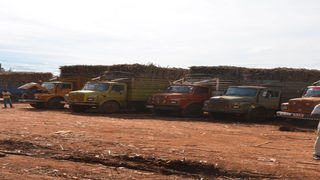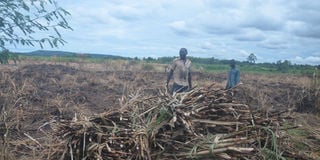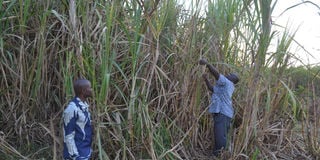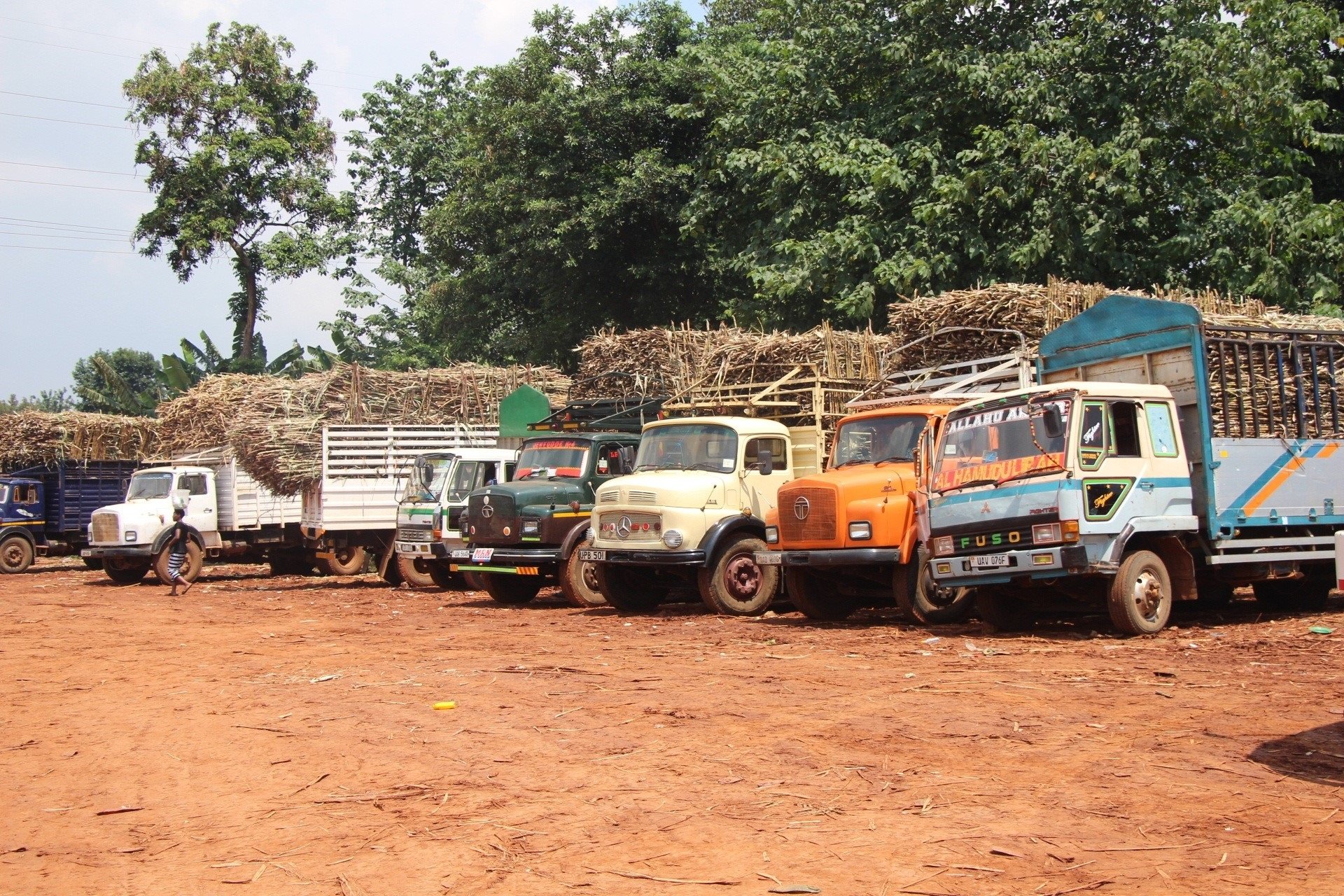
Trucks loaded with sugarcane at a factory in Mayuge. Although the volume of sugarcane produced and value exported has increased three fold over the last two decades, poverty is still prevalent within sugarcane growing communities. PHOTO/TAUSI NAKATO
|Prosper
Prime
Is prosperity eluding sugar industry?
What you need to know:
Most sugarcane farmers are stuck with overgrown cane that millers are not willing to take, low cane prices, and food insecurity.
The bittersweet relationship between sugarcane out-growers and millers is steadily developing into another ugly layer, plunging the already chaotic but lucrative sugar sub-sector into more confusion, Prosper Magazine can reveal.
According to Prosper Magazine’s investigations, this is further complicated by the inabilities of the “would be” regulator - the government, to bring the two key value chain players to order.
Despite being one of the cash crops the government is banking on to boost household incomes as well as lift nearly 30,000 farming household engaged in cane production out of poverty, Prosper Magazine has also established that the government’s move to put in place the National Sugar Policy (NSP) and the Sugar Act, 2020, has not really helped matters.
This is because the operationalisation of the two policy documents is in suspense.
As a result, the sub-sector responsible for the economic livelihood of nearly 30,000 households is at the mercy of the millers, many of whom are not only connected in terms of ownership, but also operating in cartels.

Farmers harvest sugarcane in Jinja. Farm-level sugarcane prices reported by farmers indicate that since 2019, prices received by farmers have declined by 33 to 44 percent. PHOTO/TAUSI NAKATO
It emerged last week during the presentation of a study by the Economic Policy Research Centre (EPRC) titled: Revisiting policy and institutional arrangements affecting sugarcane out-growers and millers in Uganda, that in terms of pricing, most operational millers will bury whatever hatched they have to collectively agree on a price at which they can procure out-growers canes. In most cases, the pricing is at the expense of the farmers—out-growers.
Pricing issue
While competition could be good, its brunt, especially in the absence of regulation, can be dangerous for out-growers households.
The EPRC research presented last week, reveals that between 2016 and 2017, the out-growers responded to the expanding market opportunities that followed the entry of smaller mills. But their joy was short lived because they couldn’t get attractive prices for their commodities anymore.
The unregulated marketing system led to a persistent decline in cane prices in contravention of part VII of the Sugar Act, 2020, that recommends that a fair and transparent sugarcane pricing formula would be implemented each season with oversight from a representative Sugar Board.
But the pricing criteria in the Sugar Act, 2020 is not only flawed, but also not being applied. As a result, millers have disproportionate power over determination of sugarcane price.
The farm-level sugarcane prices reported by farmers indicate that since 2019, prices received by farmers have declined by 33 to 44 percent, depending on the region. From the five years of data available, cane prices from 2019 to 2021 were more similar across the three sub-regions than in 2017 and 2018.
Cane farmers interviewed during the course of the EPRC study said the steady decline in prices started in 2018, thanks to millers wielding “their unquestionable market powers to set cane prices lower.”
Out-growers believe that the uniformity of prices across regions in the past few years could be a sign of collusion by millers from different regions in their attempt to control industry pricing. But without a Sugar Board, neither millers nor growers are obligated to agree to and abide by a sugarcane pricing formula.
Research
The EPRC report, presented at the 10th National Forum on Agriculture and Food Security, also corroborated Prosper Magazine’s investigations with revealing evidence.
Although the volume of sugarcane produced and value exported has increased three fold over the last two decades, poverty is still prevalent within sugarcane growing communities.
Poverty in the sugar cane growing community is pegged to lack of empowerment and protection of out-growers who have been relegated to the tail end of the value chain.
“Institutional and policy environment for cane production in Uganda has provided limited empowerment and protection to out-growers. This is attributed to delays in the implementation of the 2010 NSP and Sugar Act, 2020 by Ministry of Trade, Industry and Cooperatives and Ministry of Agriculture,” the EPRC senior research fellow, Dr Swaibu Mbowa noted while presenting the report last week in Kampala.
As a result, two sugarcane sub-regions-Busoga and Bunyoro have been affected. The Busoga sub-region alone remains a home to 1.2 million income-poor persons and nearly 0.4 million persons living in food poverty, according 2020 Uganda Bureau of Statistics (UBOS) data.
The report also showed that out-growers contribute about 37 per cent of national cane production, with Buganda region leading in terms of yield, followed by Busoga sub-region and Bunyoro. This is also reflected in the income, with the out growers in Bunyoro losing more compared to the other two cane growing regions.

Farmers harvest sugarcane in Jinja. PHOTO/ FILE
Surprise, surprise…
The country’s sugarcane industry three-fold (over 380 per cent) expansion in cane production over the last 20 years is not as a result of efficient use of land as a key factor of production, but through conversion of forests and public land (especially ranches) to cane growing.
The EPRC study also found out that the surge over the last two decades from about 1.5 million tons in 2000 to 5.8 million tonnes in 2020 was as a result of farmers allocating more arable land to cane as well as farmer cane acreage expansion via the land rental market—renting for sugar cane growing.
Despite the growth in production which can be entirely explained by the expansion of land harvested, from approximately 20,000 ha in 2005 to over 81,000 ha in 2020, Dr Mbowa, the lead author of the report, noted that, “Farm-level sugarcane productivity has remained static at 29 MT/ acre over those 20 years.”
Exiting cane growing
About 29,000 farming households engage in cane production in Uganda, and these farmers employ an estimated 640,000 labourers. More households took up cane growing between 2012 and 2021. And an estimated 40,000 households, at one point, took part in sugarcane growing between 2005 and 2021, reveals the research. But by close of last year, this number had declined to about 29,000.
This indicates that 28 percent of out-growers had abandoned cane growing, with the highest attrition rate (33.8 percent) occurring in the Busoga sub-region. This implies that one in every three cane farmers in Busoga have abandoned cane growing.
In the absence of a National Sugar Board (NSB) to regulate the activities in the sugarcane sub-sector, the governance of out-growers’ affairs is primarily determined by millers. Without the NSB, miller and grower agreements are broken.
“Under such circumstances, the survival of the out-growers schemes is under threat due to increased market uncertainties among out-growers,” revels the report which sector players say is an accurate representation of what is happening.
“The underlying factor under the current arrangement is to preserve the millers’ disproportionate power over sugarcane price determination. This calls for enforcing the cane pricing formula and creating functioning out-grower associations stipulated in the 2020 Sugar Act. This would prop-up the position of farmers relative to the mills in price negotiation,” says the report lead researcher.
Licensing
By 2020, the MTIC had licensed 33 mills, with a combined milling capacity of 71,850 tonnes per day—compared to the 21,700 tonnes per day provided by the 4 mills before 2005. However, only 12 mills (with processing capacity of 32,525 tonnes per day) of the 24 licensed mills within Buganda, Busoga, and Bunyoro sub-region were operational, according to the study.
During the study, it was discovered that existing millers acquired new licenses in different jurisdictions to forestall other players from establishing milling plants in the same area. This could explain why there are fewer operational mills than those licensed.
Therefore, there is need to strike conversations on the NSB as recommended by the Sugar Act 2020, to regulate the sector and improve coordination between millers and out growers, as envisioned by the 2010 National Sugar Policy (NSP).
What they say
“Millers and farmers should pull together from the same side because this sector is lucrative and can accommodate everybody. But there should be a shared vision, something that is missing,” says David Kafuko, sugar industry analyst.
“To say that sugarcane growing is responsible for poverty in the sugar growing regions in the country is a myth. Actually, these household have some disposal income. The problem is the pricing and due payment of the farmers—it takes months before they are paid. If these two issues are not solved, then we should expect disgruntlement,” Madina Guloba, senior research fellow, EPRC.
“The relationship between millers and out-growers has been mismanaged. This is why sugar cane has been code named the poverty crop yet it has the potential to enrich everybody involved in the value chain,” says Princess Kabakumba Matsiko, Bunyoro Sub-region farmers’ representative.





